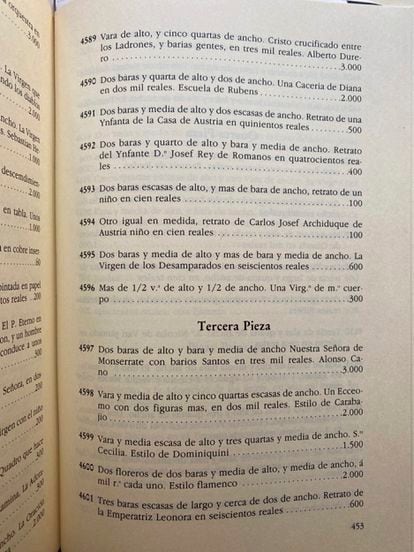The mystery around the painting attributed to Caravaggio, which was about to be auctioned in Madrid in April before being withdrawn from sale and protected as an Asset of Cultural Interest, is beginning to unravel. A canvas of the same size and motif appears in the inventories of Carlos II and Carlos III, according to revealed this Monday the magazine specialized in art Ars Magazine. Little by little, the documentary puzzle around this work, which represents an eccehomo and belongs to the Pérez de Castro family from Madrid, is completed: it appears in the inventory of the Count of Castrillo, viceroy of Naples, who brought him to Spain between 1657 and 1659. It then went on to the royal collections and from there to the Royal Academy of San Fernando, which exchanged it for a alonso cano in 1823 to the politician Evaristo Pérez Castro. Since then, until it emerged in the Ansorena room, attributed to the Ribera school and at a ridiculous price (1,500 euros) compared to its market value if it is confirmed that it is a caravaggio (more than 100 million in the international market, about 30 in Spain), remained off the radar of historians.
More information
Inventories collect all the assets of a personality at the time of death: the testamentary of Carlos II (1661-1700) refers in entry number 7793 to: “Another painting, by an excehomo, a yard and a half high: with a black frame priced at sixty doubloons = exists.” The size and motif coincide with Ansorena’s painting, although the author is not mentioned. However, in the inventory of Carlos III (1716-1788), prepared by Francisco de Goya, Jacinto Gómez and Francisco Bayeu (his two brothers-in-law), the following reference appears in number 4598: “Vara y medio de alto y cinco cuartas scant in width. An Ecceomo with two more figures in two thousand reais. Carabajio’s style ”. This inventory was studied and published by Fernando Fernández Miranda.

The painting was in the so-called Palacio de los Vargas or Palacio la Casa del Campo, as it was called then, and, according to the inventory, it was in the bedroom of Carlos II. It was a hunting lodge and, although very renovated, it is known to many Madrilenians who pass by it at one of the most frequented entrances to the Casa del Campo. “It could be plausible, but we need more data,” he says. Doomed Angel, Professor of Art History at the Complutense University and specialist in Baroque painting, who has studied the art collections in this pavilion. “Where the kings are, the rooms must be decorated. Being a place close to the Royal Palace, it has to be decorated, ”continues this historian.

These documents, according to this professor, would close one of the hypotheses that have been considered so far: that the painting passed from the Godoy collection to the Royal Academy. “We do not have any record of transfers from the royal collections to Godoy”, continues this expert who also considers a hypothesis advanced by Ars Magazine: that the painting was seized by the French troops to be integrated into the so-called Fernandino Museum, which was never inaugurated, and that it later went to the Royal Academy, he maintains that he does not know the origin of the Royal Academy, where it appears for the first time in the inventory of 1821. In the exchange document to Pérez Castro, of the four and that is why he can give it to this politician and collector.

Aterido maintains that several paintings that appear in the inventories of Carlos II and Carlos III are currently in this institution, such as the painting by Alonso Cano that appears immediately before the caravaggio in the inventory with entry 4597. He considers that it is a logical origin of the painting, although the document certifying its entry into the Royal Academy has not yet appeared, which “functioned as a depository of an enormous patrimony that had left its headquarters for different circumstances or that it came from conflicts ”.
The researcher Belén Bartolomé, who published a study on the count of Castrillo’s inventory in which the caravaggio, he also believes that it is very plausible, especially since the other painting by the Baroque artist that the viceroy of Naples brought to Spain, a SalomeIt is still in the royal collections and can be seen in the Royal Palace of Madrid. “The mystery is being cleared up,” he says. “It is logical that he could have entered the Academy through the Fernandino Museum and the French troops,” continues Bartolomé, who nevertheless considers strange that in the inventory of Carlos II it does not appear as a caravaggio. The mystery of the eccehomo is becoming clearer, but areas of shadow remain.
source https://pledgetimes.com/2021/06/the-eccehomo-attributed-to-caravaggio-belonged-to-the-royal-collections/
Disqus comments